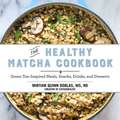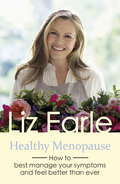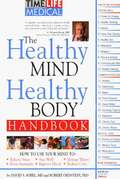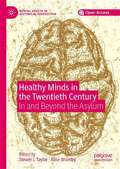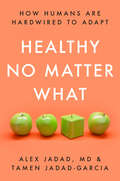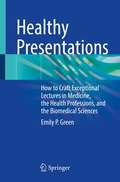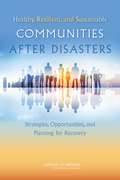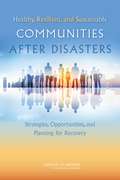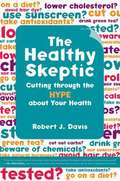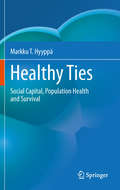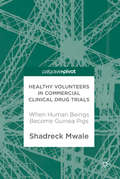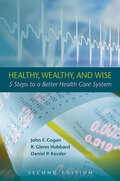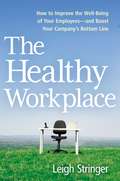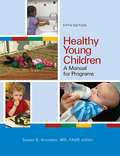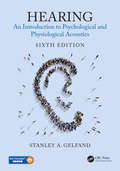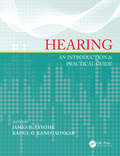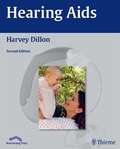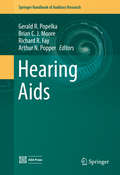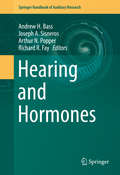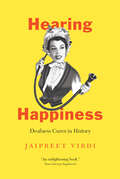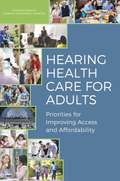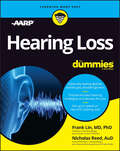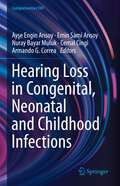- Table View
- List View
The Healthy Matcha Cookbook: Green Tea?Inspired Meals, Snacks, Drinks, and Desserts
by Miryam Quinn DoblasA Beautiful Collection of Recipes Featuring One of the World’s Most Popular and Powerful Superfoods In The Healthy Matcha Cookbook, food blogger and registered dietitian Miryam Quinn-Doblas explores the various ways matcha powder--a main component of green tea--can be incorporated into everyday recipes to give your immune system the boost it needs to keep you healthy. The health benefits of matcha powder far exceed those of green tea in drink form. The more than sixty recipes in this cookbook are easy to prepare and feature fresh, high-quality ingredients that aim to incorporate matcha powder, a powerful antioxidant, into the diet. This cookbook will take each reader on a healthy cooking journey with foolproof recipes such as: Creamy kale tomato pasta Curried coconut broccoli soup Chocolate chunk cookies Breakfast frittatas and muffins Energy truffles and bars And many more! If you want to feel better, have more energy, and decrease the amount of toxins in your body, The Healthy Matcha Cookbook is a great resource that will help you restore and strengthen your mental and physical health. This is a beautiful guide that offers home cooks of all levels the chance to transform meals into satisfying, wholesome, healthy food using one of the world’s most popular superfoods.
Healthy Menopause: How to best manage your symptoms and feel better than ever (Wellbeing Quick Guides)
by Liz EarleLiz Earle provides a complete guide to the changes that occur during menopause and explains how problems can be managed using supplements, HRT and alternative therapies.Bestselling beauty and wellbeing writer Liz Earle's fully revised and updated quick guide to a healthy menopause, including: - A guide to physical changes- Common problems and how to avoid them- The pros and cons of HRT- Conventional and natural therapies - Latest research into supplements - Essential addresses
Healthy Mind Healthy Body Handbook
by David S. Sobel Robert OrnsteinA valuable new kind of prescription for health and well-being. It offers easy-to-understand practical advice on improving physical health and leading a happier, more productive life. This book not only explains the important benefits of a healthy mind and body in simple, understandable language, but gives you practical ways to improve how you feel today. From how to manage stress, moods, and illness to communicating effectively, this book offers guidance that can make a positive impact on your life now and in the future.
Healthy Minds in the Twentieth Century: In and Beyond the Asylum (Mental Health in Historical Perspective)
by Steven J. Taylor Alice BrumbyThis open access edited collection contributes a new dimension to the study of mental health and psychiatry in the twentieth century. It takes the present literature beyond the ‘asylum and after’ paradigm to explore the multitude of spaces that have been permeated by concerns about mental well-being and illness. The chapters in this volume consciously attempt to break down institutional walls and consider mental health through the lenses of institutions, policy, nomenclature, art, lived experience, and popular culture. The book adopts an international scope covering the historical experiences of Britain, Ireland, and North America. In accordance with this broad approach, contributions to the volume span academic fields such as history, arts, literary studies, sociology, and psychology, mirroring the diversity of the subject matter. This book is available open access under a CC BY 4.0 license at link.springer.com
Healthy No Matter What: How Humans Are Hardwired to Adapt
by Alex Jadad Tamen Jadad-GarciaA provocative manifesto that teaches you how to take control of your own health, no matter your age or circumstances—from an innovative doctor and his philosopher daughter&“If you care about your health or the well-being of others, read this book.&”—Ethan Kross, author of ChatterDr. Alex Jadad is the creator of the Jadad scale, which has become the world&’s most widely used methodology to assess the quality of clinical trials, and his daughter Tamen Jadad-Garcia is a health entrepreneur and philosopher. Here they combine their expertise to uncover the medical system&’s unstable foundations, which condemn you to be ill. The Jadads begin this exploration with a simple question: &“What is health?&”Through engaging stories and case studies, the Jadads expand the understanding of health beyond the medical industrial complex. They show how distant connections in your personal networks can influence key aspects of yourself, like your weight, anxiety, and addictions; how reliance on medications can be reduced by intentionally designing the places where you live, work, and play; and how comparisons with peers can shorten your life.In this practical guide, the meaning of health is redefined, putting you in the driver&’s seat and recognizing you as the most effective evaluator. Building on data and experiences from millions of people around the world, the book reveals that a healthy life is possible even with complex chronic conditions or terminal illnesses. The Jadads explain why perceiving yourself as unhealthy might actually be fatal, and how you can monitor your true health and boost it in practically any context, no matter your cultural background or socioeconomic circumstances.With wisdom and empathy, Healthy No Matter What teaches you how your natural gift of adaptability equips you to overcome any obstacle, provides actionable pointers, and shows how and when to use the medical system, so that you can thrive, regardless of the twists and turns life may take.
Healthy Presentations: How to Craft Exceptional Lectures in Medicine, the Health Professions, and the Biomedical Sciences
by Emily P. GreenThis book is a practical guide for busy clinicians and educators within the biomedical sciences on how to improve their presentations. It includes specific, practical guidance on crafting a talk, tips on incorporating interactive elements to facilitate active learning, and before-and-after examples of improved slide design. Chapters discuss all aspects of exceptional presentations such as the identification of main concepts, organization of content, and best practices for creating lectures that are focused on the facilitation of learning rather than on passive information transfer. The examples provided are grounded in the biomedical sciences where presentations are necessarily dense and rich with critical content, making this book an essential read for anyone who lectures within a biomedical curriculum or presents at professional conferences. This book also addresses hot topics in medical education such as presenting on virtual platforms, and reviewing teaching materials for diversity, inclusion, and bias. These topics are not addressed in any other books on the market, and they address real gaps in medical and health professions training. Written from the perspective of an educator with over 20 years of experience in medical education, Healthy Presentations: How to Craft Exceptional Lectures in Medicine, the Health Professions, and the Biomedical Sciences recognizes the importance of high-quality, inclusive, and learner-centered presentations, and it provides essential guidance and support to the faculty who create them.
Healthy, Resilient, and Sustainable Communities After Disasters: Strategies, Opportunities, and Planning for Recovery
by Committee on Post-Disaster Recovery of a Community's Public Health Medical Social ServicesIn the devastation that follows a major disaster, there is a need for multiple sectors to unite and devote new resources to support the rebuilding of infrastructure, the provision of health and social services, the restoration of care delivery systems, and other critical recovery needs. In some cases, billions of dollars from public, private and charitable sources are invested to help communities recover. National rhetoric often characterizes these efforts as a "return to normal. " But for many American communities, pre-disaster conditions are far from optimal. Large segments of the U. S. population suffer from preventable health problems, experience inequitable access to services, and rely on overburdened health systems. A return to pre-event conditions in such cases may be short-sighted given the high costs - both economic and social - of poor health. Instead, it is important to understand that the disaster recovery process offers a series of unique and valuable opportunities to improve on the status quo. Capitalizing on these opportunities can advance the long-term health, resilience, and sustainability of communities - thereby better preparing them for future challenges. "Healthy, Resilient, and Sustainable Communities After Disasters" identifies and recommends recovery practices and novel programs most likely to impact overall community public health and contribute to resiliency for future incidents. This book makes the case that disaster recovery should be guided by a healthy community vision, where health considerations are integrated into all aspects of recovery planning before and after a disaster, and funding streams are leveraged in a coordinated manner and applied to health improvement priorities in order to meet human recovery needs and create healthy built and natural environments. The conceptual framework presented in "Healthy, Resilient, and Sustainable Communities After Disasters" lays the groundwork to achieve this goal and provides operational guidance for multiple sectors involved in community planning and disaster recovery. "Healthy, Resilient, and Sustainable Communities After Disasters" calls for actions at multiple levels to facilitate recovery strategies that optimize community health. With a shared healthy community vision, strategic planning that prioritizes health, and coordinated implementation, disaster recovery can result in a communities that are healthier, more livable places for current and future generations to grow and thrive - communities that are better prepared for future adversities.
Healthy, Resilient, and Sustainable Communities After Disasters: Strategies, Opportunities, and Planning for Recovery
by Committee on Post-Disaster Recovery of a Community’s Public Health Medical Social ServicesIn the devastation that follows a major disaster, there is a need for multiple sectors to unite and devote new resources to support the rebuilding of infrastructure, the provision of health and social services, the restoration of care delivery systems, and other critical recovery needs. In some cases, billions of dollars from public, private and charitable sources are invested to help communities recover. National rhetoric often characterizes these efforts as a "return to normal. " But for many American communities, pre-disaster conditions are far from optimal. Large segments of the U. S. population suffer from preventable health problems, experience inequitable access to services, and rely on overburdened health systems. A return to pre-event conditions in such cases may be short-sighted given the high costs - both economic and social - of poor health. Instead, it is important to understand that the disaster recovery process offers a series of unique and valuable opportunities to improve on the status quo. Capitalizing on these opportunities can advance the long-term health, resilience, and sustainability of communities - thereby better preparing them for future challenges. "Healthy, Resilient, and Sustainable Communities After Disasters" identifies and recommends recovery practices and novel programs most likely to impact overall community public health and contribute to resiliency for future incidents. This book makes the case that disaster recovery should be guided by a healthy community vision, where health considerations are integrated into all aspects of recovery planning before and after a disaster, and funding streams are leveraged in a coordinated manner and applied to health improvement priorities in order to meet human recovery needs and create healthy built and natural environments. The conceptual framework presented in "Healthy, Resilient, and Sustainable Communities After Disasters" lays the groundwork to achieve this goal and provides operational guidance for multiple sectors involved in community planning and disaster recovery. "Healthy, Resilient, and Sustainable Communities After Disasters" calls for actions at multiple levels to facilitate recovery strategies that optimize community health. With a shared healthy community vision, strategic planning that prioritizes health, and coordinated implementation, disaster recovery can result in a communities that are healthier, more livable places for current and future generations to grow and thrive - communities that are better prepared for future adversities.
The Healthy Skeptic: Cutting Through the Hype about Your Health
by Robert J. DavisIt happens every day: we pick up a newspaper or magazine or turn on the television and are bombarded with urgent advice about how to stay healthy. Lose weight! Lower your cholesterol! Early detection saves lives! Sunscreen prevents cancer! But in many cases, pronouncements we rarely think to question turn out to be half-truths that are being pushed by various individuals or groups to advance their own agendas. The Healthy Skeptic explores who these health promoters are--from journalists and celebrities to industry-funded groups and consumer activists--what their motives are, and how they are spinning us in ways we often don't realize. This treasure trove of little-known facts, written by a seasoned health reporter, provides invaluable tips, tools, and resources to help readers think more critically about what they're being told. Becoming a healthy skeptic is vital, Davis argues, because following the right advice can have a profound impact on overall health and longevity.
Healthy Ties
by Markku T. HyyppäSocial capital is a widely acknowledged candidate for implementing beneficial democratic processes and promoting public health. Healthy ties. Social capital, population health and survival traces the path from the conceptualization to the implementation of social capital. To provide empirical proof of the effects of social capital on public health is a serious challenge and the main focus of the book. In the Nordic countries, personal identification codes linking data from various sources, nation-wide population registers, nationally representative and re-tested health surveys, and the long tradition of epidemiology submit to serve well the research into social capital and public health. Up-to-date longitudinal data on social capital and health outcomes are carefully described and reviewed in this book. In Finland, the Swedish-speaking minority is very long-lived and has better health as compared with the Finnish-speaking majority.
Healthy Volunteers in Commercial Clinical Drug Trials
by Shadreck MwaleThis book provides a richly detailed contribution to the understanding of healthy volunteer experiences in clinical drug trials in the UK. Contemporary society, especially the West, has seen a significant increase in the production and use of pharmaceutical products, particularly for disease treatment. However, despite the large numbers of people involved, particularly in the UK, very little is known about their experiences in commercial phase I clinical drug trials. Shadreck Mwale critiques common conceptions of the terms 'volunteer' and 'altruism' as used in policy and practice of human involvement in clinical trials and calls for an awareness of the complexity of the terms and how the social contexts participants find themselves in shape acts of voluntarism. Based on extensive empirical evidence and conceptual analysis, the book presents new insights into the lives of healthy volunteers, challenges bioethical conceptions and generates new frameworks for policy and practice of FIHCTs. It will be of particular interest to scholars and practitioners in the wider social sciences, medical Sociology and medical anthropology, pharmacology and bioethics.
Healthy, Wealthy, and Wise: 5 Steps to a Better Health Care System, Second Edition (Aei Hoover Policy Ser.)
by John F. Cogan R. Glenn Hubbard Daniel P. KesslerIn this second edition of their 2005 work, the authors offer market-based alternatives to recent health care reforms that center on tax changes, insurance market changes, and the redesign of Medicare and Medicaid. They show that, by promoting cost- conscious behavior and competition in both private markets and government programs such as Medicare and Medicaid, we can slow the rate of growth of health care costs, expand access to high-quality health care, and slow down runaway spending.
The Healthy Workplace: How to Improve the Well-Being of Your Employees---and Boost Your Company's Bottom Line
by Leigh StringerIs your workplace working for you and your employees? Studies show that unhealthy work habits, like staring at computer screens and rushing through fast-food lunches are taking their toll in the form of increased absenteeism, lost productivity, and higher insurance costs--but it doesn't have to be that way.Companies such as Google, Apple, Aetna, and Johnson & Johnson have used innovative techniques to incorporate healthy habits and practices into the workday and into their culture--with impressive ROI. Packed with real-life examples and the latest research, The Healthy Workplace proves that it pays to invest in your people's well-being and reveals how to:Create a healthier, more energizing environmentReduce stress to enhance concentrationInspire movement at workUse choice architecture to encourage beneficial behaviorsSupport better sleepHeighten productivity without adding hours to the workdayFilled with tips for immediate improvement and guidelines for building a long-term plan, The Healthy Workplace will boost both employee well-being and the bottom line.
Healthy Young Children: A Manual For Programs
by Susan Aronson"Now in its fifth edition, Healthy Young Children has been used in hundreds of early childhood settings to promote the health, nutrition, and safety of children, staff members, and families. This edition contains a new chapter on promoting children's health through physical activity. Also included are updated standards, procedures, and resources, including sample forms, letters, and checklists. This manual is an invaluable resource for program directors, consultants working with early childhood programs, teacher educators, professional development staff, and other concerned about keeping children and adults safe and healthy"
Healthy Young Children: A Manual for Programs
by Susan S. AronsonAs program directors, teachers, students learning to be teachers, or other professionals working with child care facilities, you mush be able to protect and promote the health and well-being of the young children, staff, and families in child care. .
Hearing: An Introduction to Psychological and Physiological Acoustics, Sixth Edition
by Stanley A. GelfandThis fully updated and revised sixth edition of Hearing: An Introduction to Psychological and Physiological Acoustics provides a comprehensive introduction for graduate students and professionals in audiology and other fields dealing with audition (including hearing/speech science, psychology, otolaryngology, neuroscience, linguistics, and speech-language pathology). The sixth edition reflects the current status of this rapidly-evolving multidisciplinary field of hearing science.
Hearing: An Introduction & Practical Guide
by James Tysome Rahul KanegaonkarHearing is essential for normal communication. We are able to localise sound with surprising accuracy and can detect time differences as small as the time it takes for sound to pass from the mouth of one person to the ear of another. However, hearing loss is underdiagnosed, poorly understood and a common cause of social isolation. <P><P>Hearing: An Introduction and Practical Guide provides a basic understanding of the science of hearing, the causes of hearing loss and how hearing loss can be clinically assessed and effectively treated. The book is divided into three sections, beginning with a review of the basic anatomy, physiology and principles of hearing. The second section addresses clinical and audiological assessment of hearing as well as imaging of the ear. The third section features an extensive series of chapters on focused topics covering the range of causes of hearing loss, their management and options for hearing rehabilitation. <P><P> Clear, concise and comprehensive, Hearing: An Introduction and Practical Guide is an excellent source of information for ENT surgeons, general practitioners and trainees. It presents a quick reference and practical guide for assessing and managing patients with hearing loss.
Hearing Aids
by Harvey DillonIt's revised to reflect the research and technological advances of the last decade, New chapters on directional microphones and the latest digital signal processing strategies, coverage of all aspects of open-canal, thin-tube hearing aids, tips, tables, and procedures designed to be pinned on the walls of clinics, each cross-referenced chapter builds on the previous chapters. It has a one-page synopsis that captures the key concepts of each topic. The material that students need is contained in marked paragraphs to form a coherent thin book inside the larger book. Intervening additional paragraphs add satisfying depth.
Hearing Aids
by Gerald R. Popelka Brian C. J. Moore Richard R. Fay Arthur N. PopperThis volume will serve as the first Handbook of its kind in the area of hearing aid research, often the least-defined, least-understood, part of the multi-disciplinary research process. Most scientific training is very advanced within the particular disciplines but provides little opportunity for systematic introduction to the issues and obstacles that prevent effective hearing-aid related research. This area has emerged as one of critical importance, as signified by a single specialized meeting (the International Hearing Aid Conference, IHCON) that brings together specialists from the disparate disciplines involved, including both university and industry researchers. Identification of the key steps that enable high-impact basic science to ultimately result in significant clinical advances that improve patient outcome is critical. This volume will provide an overview of current key issues in hearing aid research from the perspective of many different disciplines, not only from the perspective of the key funding agencies, but also from the scientists and clinicians who are currently involved in hearing aid research. It will offer insight into the experience, current technology and future technology that can help improve hearing aids, as scientists and clinicians typically have little or no formal training over the whole range of the individual disciplines that are relevant. The selection and coverage of topics insures that it will have lasting impact, well beyond immediate, short-term, or parochial concerns.
Hearing and Hormones
by Andrew H. Bass Joseph A. Sisneros Arthur N. Popper Richard R. FayThis book reviews the growing literature that is consistent with the hypothesis that hormones can regulate auditory physiology and perception across a broad range of animal taxa, including humans. Understanding how hormones modulate auditory function has far reaching implications for advancing our knowledge in the basic biomedical sciences and in understanding the evolution of acoustic communication systems. A fundamental goal of neuroscience is to understand how hormones modulate neural circuits and behavior. For example, steroids such as estrogens and androgens are well-known regulators of vocal motor behaviors used during social acoustic communication. Recent studies have shown that these same hormones can also greatly influence the reception of social acoustic signals, leading to the more efficient exchange of acoustic information.
Hearing Happiness: Deafness Cures in History (Chicago Visions and Revisions)
by Jaipreet VirdiAt the age of four, Jaipreet Virdi’s world went silent. A severe case of meningitis left her alive but deaf, suddenly treated differently by everyone. Her deafness downplayed by society and doctors, she struggled to “pass” as hearing for most of her life. Countless cures, treatments, and technologies led to dead ends. Never quite deaf enough for the Deaf community or quite hearing enough for the “normal” majority, Virdi was stuck in aural limbo for years. It wasn’t until her thirties, exasperated by problems with new digital hearing aids, that she began to actively assert her deafness and reexamine society’s—and her own—perception of life as a deaf person in America. Through lyrical history and personal memoir, Hearing Happiness raises pivotal questions about deafness in American society and the endless quest for a cure. Taking us from the 1860s up to the present, Virdi combs archives and museums in order to understand the long history of curious cures: ear trumpets, violet ray apparatuses, vibrating massagers, electrotherapy machines, airplane diving, bloodletting, skull hammering, and many more. Hundreds of procedures and products have promised grand miracles but always failed to deliver a universal cure—a harmful legacy that is still present in contemporary biomedicine. Weaving Virdi’s own experiences together with her exploration into the fascinating history of deafness cures, Hearing Happiness is a powerful story that America needs to hear.
Hearing Health Care for Adults: Priorities for Improving Access and Affordability
by National Academies of Sciences Engineering MedicineThe loss of hearing - be it gradual or acute, mild or severe, present since birth or acquired in older age - can have significant effects on one's communication abilities, quality of life, social participation, and health. Despite this, many people with hearing loss do not seek or receive hearing health care. The reasons are numerous, complex, and often interconnected. For some, hearing health care is not affordable. For others, the appropriate services are difficult to access, or individuals do not know how or where to access them. Others may not want to deal with the stigma that they and society may associate with needing hearing health care and obtaining that care. Still others do not recognize they need hearing health care, as hearing loss is an invisible health condition that often worsens gradually over time. In the United States, an estimated 30 million individuals (12.7 percent of Americans ages 12 years or older) have hearing loss. Globally, hearing loss has been identified as the fifth leading cause of years lived with disability. Successful hearing health care enables individuals with hearing loss to have the freedom to communicate in their environments in ways that are culturally appropriate and that preserve their dignity and function. Hearing Health Care for Adults focuses on improving the accessibility and affordability of hearing health care for adults of all ages. This study examines the hearing health care system, with a focus on non-surgical technologies and services, and offers recommendations for improving access to, the affordability of, and the quality of hearing health care for adults of all ages.
Hearing Loss and Healthy Aging: Workshop Summary
by Tracy A. LustigBeing able to communicate is a cornerstone of healthy aging. People need to make themselves understood and to understand others to remain cognitively and socially engaged with families, friends, and other individuals. When they are unable to communicate, people with hearing impairments can become socially isolated, and social isolation can be an important driver of morbidity and mortality in older adults. Despite the critical importance of communication, many older adults have hearing loss that interferes with their social interactions and enjoyment of life. People may turn up the volume on their televisions or stereos, miss words in a conversation, go to fewer public places where it is difficult to hear, or worry about missing an alarm or notification. In other cases, hearing loss is much more severe, and people may retreat into a hard-to-reach shell. Yet fewer than one in seven older Americans with hearing loss use hearing aids, despite rapidly advancing technologies and innovative approaches to hearing health care. In addition, there may not be an adequate number of professionals trained to address the growing need for hearing health care for older adults. Further, Medicare does not cover routine hearing exams, hearing aids, or exams for fitting hearing aids, which can be prohibitively expensive for many older adults. "Hearing Loss and Healthy Aging" is the summary of a workshop convened by the Forum on Aging, Disability, and Independence in January 2014 on age-related hearing loss. Researchers, advocates, policy makers, entrepreneurs, regulators, and others discussed this pressing social and public health issue. This report examines the ways in which age-related hearing loss affects healthy aging, and how the spectrum of public and private stakeholders can work together to address hearing loss in older adults as a public health issue.
Hearing Loss For Dummies
by Nicholas Reed Frank LinImprove your hearing, enhance your life With new advice on just-released over-the-counter hearing aids Hearing loss can be frustrating, but in fact it&’s common and treatable. Hearing Loss For Dummies, written by top experts in the field in collaboration with AARP, walks you through how to get the help you need to clearly hear the sounds of life—whether you&’re at home, at work, or out and about. And hearing health is critical: Hearing loss can increase your risk of falls and injuries, isolation and depression, and even cognitive decline and dementia. Authors Frank Lin and Nicholas Reed at the Johns Hopkins School of Medicine lay out the steps to hearing health: Understanding how hearing works—and how it changes as we age Finding specialists you can trust Determining whether you need testing and, if so, where to turn Learning practical solutions for hearing better at home, at work, on the phone, and in restaurants and theaters Choosing the right hearing aid, including just-approved over-the-counter hearing aids, and getting them adjusted to work for you Exploring the pros and cons of cochlear implants and other surgical options Covering the costs of hearing health careIf you&’re concerned about your own or a friend or relative&’s hearing, this is the one book you&’ll need. For what can seem like a complicated, stressful and lengthy process, Hearing Loss For Dummies tackles the topic head-on and provides you with expert guidance to put your mind at ease on the path to better hearing.
Hearing Loss in Congenital, Neonatal and Childhood Infections (Comprehensive ENT)
by Ayşe Engin Arısoy Emin Sami Arısoy Nuray Bayar Muluk Cemal Cingi Armando G. CorreaThis book provides a broader understanding of infectious diseases and hearing loss prevention and treatment in children. In addition to all the common infections, the book covers the prion diseases, the autoinflammatory syndromes, and diseases of unknown etiology. A specific chapter is dedicated to cochlear implant infections. The final part reviews the available therapeutic agents. Written by international experts, the book will appeal to a wide readership, from ENT and pediatrics trainees, to practitioners and researchers in these disciplines.
